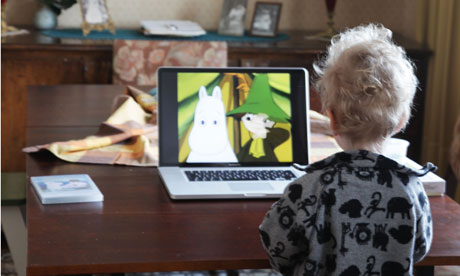While children of all ages need guidance and parameters for healthy media use, young children in particular need limits on their media exposure. If you have an infant, toddler, or preschooler, here is what you need to know to establish a healthy media diet and an environment that nurtures your child’s growth and development.
The American Academy of Pediatrics recommends no screen time—computers, smart phones, TV—for children under two years. During the first two years of life, babies’ brains triple in size. This incredible neurological growth requires interaction with a loving caregiver and three-dimensional exploration.
Media exposure steals time away from these activities and may create delays in crucial areas of growth and learning, including language development.
Before turning your 2-year-old loose in front of a screen, think through and implement household rules and practices that will establish a solid foundation for a healthy media diet as your child develops. To do this, consider media and technology use in terms of quantity, quality, context, and control.
Quantity: Most child development and parenting experts recommend no more than one to two hours of screen time a day—and that all screen time be balanced with unplugged play. The importance of play —particularly unstructured and imaginative play—cannot be under-estimated, because it helps children learn essential skills such as emotional regulation, turn-taking, impulse control, problem-solving, and reasoning and fosters creativity and innovation. Watching or interacting with even educational media cannot take the place of play as an invaluable source for social, emotional, and cognitive development.
Quality: Choose programs, videos, and games that are educational rather than strictly entertaining in nature. While educational media do not take the place of more effective means of learning (e.g., face-to-face interaction, including talking and being read to), they can enhance learning, particularly in the area of social and emotional skills. Select programs that are slow, linear, repetitive, and interactive, with dialogue and action closely linked. Adult interaction—by a parent, caregiver, or teacher—enhances the value of the experience. Choose commercial-free programs that send positive messages. Dora the Explorer, Sesame Street, Between the Lions, Blues Clues, Dragon Tales, and Clifford all receive high marks from child development researchers.
Context: Don’t make media use the default activity, schedule it instead. Establish a specific time and place when your child can watch a program or play on the computer, i.e., for a half hour while you are making dinner or on Saturday mornings after breakfast. Set a buzzer to go off when the designated time is up. This will help you track media use more effectively—ensuring that you don’t exceed your one-to-two-hour-daily cap—and send a clear message to your kids that their time is up and there’s no use in whining about it or begging for another five minutes.
Establishing context also means not using media and technology as a substitute for child care and soothing. Handing over your iPhone when your child is cranky and restless inadvertently trains them to turn to technology for comfort rather to another human being. Children also need to learn to self-soothe and keep themselves entertained. Overuse of media and technology deprives them of the opportunity to learn and practice these necessary life skills.
Finally, to set a clear context for when media should and shouldn’t be used, you will need to be a role model. This means refraining from checking your Blackberry or answering your phone during meal times and giving your child your full attention during play and other quality time together. If you are constantly checking your phone while engaging in other activities, your child will learn that your phone is your priority and that it is okay to not give someone or something your full attention.
Control: You are in control of media use, not your child. Establish a rule that your child must first ask your permission before turning on the TV or a computer. This helps establish context, enables you to monitor time spent on media, and places you firmly in charge of the when, where, and what of media use. Keep media and technology in a central, easily monitored location in your household. This means no TVs or computers in your child’s room, at least for now.
Once your child has a cell phone or laptop, it will be more difficult to enforce this rule, so establish the foundation for healthy media use now to embed it into the culture and practices of your family. As your child grows and is exposed to more media and friends whose families may have different rules for media use, stay true to your beliefs and rules. It is all too easy to be swayed by “but all my friends play that game/have cell phones/have their own laptops.” For more on establishing a healthy media diet for your children, check out Common SenseMedia, an essential resource for parents and educators. Its website provides a wealth of information: from reviews of videos, games, and apps to tips and strategies for teaching children of all ages how to be safe and responsible online.




